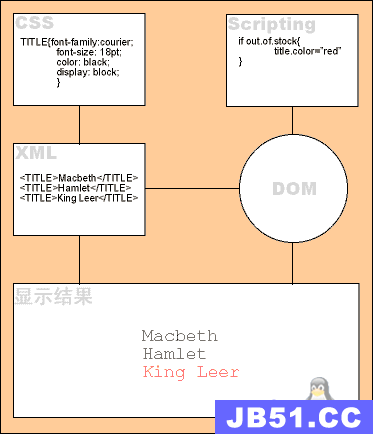1 综述
有很多种解析方法。
(1) DOM 缺点是:1 不能解析格式不正确或者不规则xml 2据说只能解析utf-8格式,非utf-8需要转码
与SAX比较,DOM典型的缺点是比较慢,消耗更多的内存,因为DOM会将整个XML数读入内存中,并为树
中的第一个节点建立一个对象。使用DOM的好处是你不需要对状态进行追踪,因为每一个节点都知道谁是它的
父节点,谁是子节点。但是DOM用起来有些麻烦。
Python中使用minidom解析xml,会遇到编码问题。minidom支持UTF-8的编码,对于其他的编码,必须进行转换,否则解析时会产生异常。下面以读取gb2312编码的xml文件为例。
sourceFile = codecs.open(sourceFilePath,mode='r')
xmlContentStr = sourceFile.read()
xmlContentStr = xmlContentStr.decode('gb2312').encode('utf-8')
xmlContentStr =xmlContentStr.replace('encoding="gb2312"','encoding="utf-8"')
sourceXML = minidom.parseString(xmlContentStr)
(2)beatifulsoup 特点是可以处理格式不正确的html文档
(3).SAX (simple API for XML )
pyhton 标准库包含SAX解析器,SAX是一种典型的极为快速的工具,在解析XML时,不会占用大量内存。
但是这是基于回调机制的,因此在某些数据中,它会调用某些方法进行传递。这意味着必须为数据指定句柄,
以维持自己的状态,这是非常困难的。
(4) ElementTree(元素树)
ElementTree就像一个轻量级的DOM,具有方便友好的API。代码可用性好,速度快,消耗内存少,这里主要
介绍ElementTree。
2DOM(Document Object Model)
与SAX比较,DOM典型的缺点是比较慢,消耗更多的内存,因为DOM会将整个XML数读入内存中,并为树父节点,谁是子节点。但是DOM用起来有些麻烦。
一 、xml.dom 解析XML的API描述
minidom.parse(filename)
加载读取XML文件
doc.documentElement
获取XML文档对象
node.getAttribute(AttributeName)
获取XML节点属性值
node.getElementsByTagName(TagName)
获取XML节点对象集合
node.childNodes #返回子节点列表。
node.childNodes[index].nodeValue
获取XML节点值
node.firstChild
#访问第一个节点。等价于pagexml.childNodes[0]
doc = minidom.parse(filename)
doc.toxml('UTF-8')
返回Node节点的xml表示的文本
Node.attributes["id"]
a.name #就是上面的 "id"
a.value #属性的值
访问元素属性
二、代码演示
<?xml version="1.0" encoding="UTF-8" ?>
<users>
user id="1000001">
username>Admin</email>admin@live.cnage>23sex>男user="1000002">Admin2>admin2@live.cn>22="1000003">Admin3>admin3@live.cn>27="1000004">Admin4>admin4@live.cn>25>女="1000005">Admin5>admin5@live.cn>20="1000006">Admin6>admin6@live.cn>
>
2、Demo.py解析user.xml文档数据
"""
* User: lhj588
* Date: 11-11-9
* Time: 13:20
* Desc:
"""
from xml.dom import minidom
def get_attrvalue(node,attrname):
return node.getAttribute(attrname) if node else ''
def get_nodevalue(node,index = 0):
return node.childNodes[index].nodeValue def get_xmlnode(node,name):
return node.getElementsByTagName(name) else []
def xml_to_string(filename='user.xml'):
doc = minidom.parse(filename)
return doc.toxml(UTF-8')
def get_xml_data(filename='):
doc = minidom.parse(filename)
root = doc.documentElement
user_nodes = get_xmlnode(root,user')
user_list=[]
for node in user_nodes:
user_id = get_attrvalue(node,0); line-height:1.5!important">id')
node_name = get_xmlnode(node,0); line-height:1.5!important">username')
node_email = get_xmlnode(node,0); line-height:1.5!important">email')
node_age = get_xmlnode(node,0); line-height:1.5!important">age')
node_sex = get_xmlnode(node,0); line-height:1.5!important">sex')
user_name =get_nodevalue(node_name[0]).encode(utf-8',0); line-height:1.5!important">ignore')
user_email = get_nodevalue(node_email[0]).encode(')
user_age = int(get_nodevalue(node_age[0]))
user_sex = get_nodevalue(node_sex[0]).encode(')
user = {}
user['],user['] = (
int(user_id),user_name,user_email,user_age,user_sex
)
user_list.append(user)
return user_list
def test_xmltostring():
print xml_to_string()
def test_laod_xml():
user_list = get_xml_data()
for user in user_list :
print user['sex']
print -----------------------------------------------------'
if user:
user_str=编 号:%d\n用户名:%s\n性 别:%s\n年 龄:%s\n邮 箱:%s\n ' % (int(user[']),0); line-height:1.5!important">'])
print user_str
====================================================='
if __name__ == "__main__":
test_xmltostring()
test_laod_xml()
3、测试效果
A、测试toxml
demo.py 文件中修改成
if __name__ == "__main__":
test_xmltostring()
执行打印结果:
B、测试解析XML
demo.py 文件中修改成
if __name__ == "__main__":
test_laod_xml()
执行打印出结果:
-----------------------------------------------------
编 号:1000001
用户名:Admin
性 别:男
年 龄:23
邮 箱:admin@live.cn
=====================================================
-----------------------------------------------------
编 号:1000002
用户名:Admin2
性 别:男
年 龄:22
邮 箱:admin2@live.cn
=====================================================
-----------------------------------------------------
编 号:1000003
用户名:Admin3
性 别:男
年 龄:27
邮 箱:admin3@live.cn
=====================================================
-----------------------------------------------------
编 号:1000004
用户名:Admin4
性 别:女
年 龄:25
邮 箱:admin4@live.cn
=====================================================
-----------------------------------------------------
编 号:1000005
用户名:Admin5
性 别:男
年 龄:20
邮 箱:admin5@live.cn
=====================================================
-----------------------------------------------------
编 号:1000006
用户名:Admin6
性 别:女
年 龄:23
邮 箱:admin6@live.cn
=====================================================
转自:http://www.cnblogs.com/lhj588/archive/2011/11/09/2242483.html
3 Beautiful Soup
Beautiful Soup 是用 Python 写的一个 HTML/XML 的解析器,它可以很好的处理不规范标记并生成剖析树。通常用来分析爬虫抓取的web文档。对于 不规则的 Html文档,也有很多的补全功能,节省了开发者的时间和精力。
Beautiful Soup 的官方文档齐全,将官方给出的例子实践一遍就能掌握。官方英文文档,中文文档
一 安装Beautiful Soup
安装 BeautifulSoup 很简单,下载BeautifulSoup源码。解压运行
python setup.py install 即可。
测试安装是否成功。键入 import BeautifulSoup 如果没有异常,即成功安装
二 使用 BeautifulSoup
1. 导入BeautifulSoup ,创建BeautifulSoup 对象
|
1
2
3
4
5
6
7
8
9
10
11
12
|
from
BeautifulSoup
import
BeautifulSoup
# HTML
BeautifulStonesoup
# XML
# ALL
doc
=
[
'<html><head><title>Page title</title></head>'
,
'<body><p id="firstpara" align="center">This is paragraph <b>one</b>.'
ottom:auto!important; float:none!important; height:auto!important; left:auto!important; line-height:1.1em!important; outline:0px!important; overflow:visible!important; position:static!important; right:auto!important; top:auto!important; vertical-align:baseline!important; width:auto!important; font-family:Consolas,
'<p id="secondpara" align="blah">This is paragraph <b>two</b>.'
ottom:auto!important; float:none!important; height:auto!important; left:auto!important; line-height:1.1em!important; outline:0px!important; overflow:visible!important; position:static!important; right:auto!important; top:auto!important; vertical-align:baseline!important; width:auto!important; font-family:Consolas,
'</html>'
]
# BeautifulSoup 接受一个字符串参数
soup
BeautifulSoup(''.join(doc))
|
2. BeautifulSoup对象简介
用BeautifulSoup 解析 html文档时,BeautifulSoup将 html文档类似 dom文档树一样处理。BeautifulSoup文档树有三种基本对象。
2.1. soup BeautifulSoup.BeautifulSoup
type
(soup)
<
class
'BeautifulSoup.BeautifulSoup'
>
|
2.2. 标记 BeautifulSoup.Tag
>>> html = soup.html
>>> html
<
html
><
head
title
>Page title</
></
body
p
id
=
"firstpara"
align
"center"
>This is paragraph<
b
>one</
>.</
p
"secondpara"
"blah"
>two</
>
>>> type(html)
class
'BeautifulSoup.Tag'>
>>> title = soup.title
content方法
|

